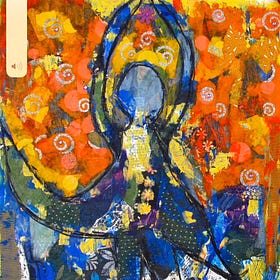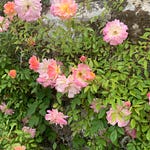
Good morning on this beautiful Saturday in June. It’s still early, and I’ve already had my first cup of tea, watched a few documentaries on YouTube, and now I’m happily immersed in a film about life in a remote Romanian village—courtesy of a dear friend. I’ll share the link below, as I think you might enjoy it. It offers a breath of real life in an age that often feels padded in plastic and artificiality.
But let’s rewind to yesterday, when another walk in my favourite place sparked today’s monologue—or rant, if you like. Picture this: well-behaved, law-abiding citizens strolling peacefully through the park, fully kitted out for what appears to be a light expedition across Patagonia. Some wear heavy-duty walking boots, carry two trekking poles, sport a rucksack the size of a weekend getaway bag, and—of course—the pièce de résistance: the water bottle. Always the water bottle.
Never mind that the terrain is absolutely flat, the path well-kept, and the total distance would barely qualify as a warm-up for Everest. No, the gear must come along. Because gear means something. Or at least, it looks good. It says, “I’m doing health. I’m doing fitness. I’m prepared.”
The water bottles dangle from their hands—some a litre, some even larger, a few daintier ones thrown in for variety. The spectrum of colours and designs is truly something to behold. And that brings me neatly to today’s topic: water bottles and the sacred act of drinking water.
Why do we need all this channanigang? Why the elaborate theatrical display of hiking regalia without the faintest hint of situational awareness? Why the unquestioning obedience to advice no one seems to trace back to its origins? Where, oh where, is good old-fashioned common sense? Is it on permanent leave?
When I was growing up, we had something called a thermos. You can still find them in shops—made from some sturdy, space-age metallic alloy. We used them for water, for coffee, for long trips. You might say, “Aha! See? You had your version of the water bottle.” Yes, we did. But it was one. It lasted twenty years. It had dents. It had a past. It smelled of mountain air, train journeys, and sweet family memories—memories you recall with a smile, or sometimes with a silent prayer.
Today? Water bottles are everywhere. They’re promotional gifts. I’d bet good money that marketing executives have entire cupboards full of them—each one branded like a map of their consumer journey: hotels, coffee shops, conferences, amusement parks, yoga retreats. All with charming labels. All saying, “You were here, and you drank water.”
And yet we keep buying more. One bottle. Then another. And another. Why?
Ah yes—the virus. The consumerism virus. It infected the last three or four generations with alarming efficiency. And once it took hold, it spread with flair. People began infecting others, joyfully, almost religiously. And before long, it all became normal.
It’s as if a program were installed—yes, like in a computer. No one pauses to ask why they’re buying their 25th water bottle. They just do. Because the virus whispered: “You need this.” It all reminds me of The Matrix—with those little devices people had plugged into them, controlling behaviour, tracking their every move, feeding them the latest software update for “normality.”
And what’s most impressive? This programming coexists—perfectly peacefully—with another program: “Save the planet. No more plastic.” Same person. Same body. One moment they’re giving speeches about microplastics, dirty oceans, overconsumption. The next, they’re in a shop buying yet another reusable bottle or ordering a branded batch for their next sustainability-themed conference.
It's a masterpiece of modern programming—contradictory systems living harmoniously within the same mind. This is not just marketing. This is brainwashing deluxe.
And let’s not forget the infantilisation aspect. I don’t remember being told to drink water when I was thirsty back in the day. In fact, it wasn’t until I moved to another country that the mantras began: “Two litres a day.” “10,000 steps.” A chorus of wellness commands began drilling into my head, right alongside the idea that if something didn’t feel natural, it was probably my fault.
For years, a part of me—let’s call her the Inner Rebel—kept scratching her head. Politely at first. Then more insistently. Because something didn’t sit right. I tried to comply. I really did. But trying is the key word here.
Years went by, and my questions started to get louder. The virus was strong, but I had something on my side: I grew up in a communist country. Say what you will, but that upbringing teaches you to question things. Relentlessly.
And once you see behind the veil, you can’t unsee it. Once you realise that this “two litres a day” idea was just some figure floated by some committee, one day, somewhere, and then repeated until it became gospel—you pause. You dig. You resist. You see the whole campaign for what it is. The fancy water bottle as modern amulet. A red flag flapping in the wind.
You realise that it’s all part of a bigger system—a system where infantilisation and blind obedience are the end goals. You start questioning even harder. Every instruction. Every lifestyle “rule.” Every shiny new item pushed as a “must.”
Meanwhile, the so-called civilised world looks down on peasants in remote villages, or tribes far removed from the noise of modernity. Curious, isn’t it? How do they survive, those poor souls, without the modern citizen advising them on hydration schedules and equipping them with the latest smart bottle? Poor, poor them.
Until next time, be well!
💖 Ways to Support My Work & Mission
🖼️ Buy my artwork:
Fine Art America | Redbubble
📚 Explore my journals & workbooks:
Available on Amazon
🎁 Buy Me a Coffee – plus explore downloadable digital tools & coaching options:
Support here
Whispers Behind Slammed Doors - Naked truth chapter 39
Note for New ReadersSoul to soul stories is a reader-supported publication. To receive new posts and support my work, consider becoming a free or paid subscriber.













Share this post